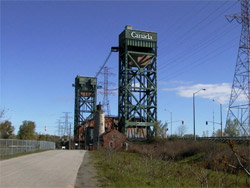Burlington Canal Lift Bridge
 The Burlington Canal Lift Bridge is located on the western shore of Lake Ontario on a site rich in history. The bridge spans the Burlington Canal that was opened in 1826. Once a narrow cut, the canal now provides Burlington Bay (Hamilton Harbour) with navigable access to the Atlantic Ocean. The canal connected the Hamilton Harbour industrial region to international trade and commerce. It was among a series of waterway projects begun, 200 years ago, to provide navigation from Lake Erie to the Atlantic Ocean. Today the Burlington Canal remains a busy waterway and is vital to the area commerce.
The Burlington Canal Lift Bridge is located on the western shore of Lake Ontario on a site rich in history. The bridge spans the Burlington Canal that was opened in 1826. Once a narrow cut, the canal now provides Burlington Bay (Hamilton Harbour) with navigable access to the Atlantic Ocean. The canal connected the Hamilton Harbour industrial region to international trade and commerce. It was among a series of waterway projects begun, 200 years ago, to provide navigation from Lake Erie to the Atlantic Ocean. Today the Burlington Canal remains a busy waterway and is vital to the area commerce.
There were five different moveable bridges located on this site since 1830. The present bridge was opened in 1962 and carried two lanes of vehicular traffic across the canal. This structure originally had tracks for the Hamilton — Northwestern railway which were removed in 1982 when the road way was widened to four lanes.
The bridge structure is a tower driven, vertical lift and moveable bridge. The lift span is 116 metres long, weighs 1,996 tonnes and has a vertical lift of 33.5 metres.
- At full lift height, maximum clearance for marine traffic is approximately 36.5 metres during typical water level conditions.
- When locked in its lowered position, a clearance of approximately 5 metres, during typical water level conditions, allows very small pleasure craft, kayaks and canoes to pass easily beneath the bridge.
A system originating in the towers contains machinery, sheaves and wire ropes, moves the lift span. There is one 150 horsepower drive motor in each tower to supply power to the machinery and one 150 horsepower motor in each tower to synchronize the drive motors.
The navigation season usually runs from late March to late December. During the winter shut down, the bridge staff overhaul the tower drive gear.
Since its installation, the bridge has been operated in excess of 166,380 times, allowing the passage of over 250,000 vessels. On a yearly basis, the bridge will operate approximately 4000 times allowing approximately 6500 vessels to pass through the canal; this includes more than 1000 cargo-carrying vessels.
The bridge lifts on-demand for all large vessels and on the hour and half hour for pleasure craft. In order to ensure safety, the bridge must be raised early since in the event of a failure, we need to provide the vessel time to turn since a fully loaded vessel can take in excess of a mile to stop.
Information Resources for Marine Traffic
Boaters can access updates about scheduled lifts through two channels.
- Telephone: 905-544-3236
- UVF/VHF Radio Channel #16
Burlington Canal Lift Bridge Drives, Controls and Overhead Cables Project
The Drives and Controls and Overhead Cables Project
The Burlington Canal Lift Bridge is undergoing a four-year project to replace the drives and controls for the lifting mechanism and related works. The bridge’s controls, drives and associated electrical components have been in operation for over fifty years and have reached the end of their service life. The proactive replacement of these components will alleviate the risk of failure and emergency repair and improve the performance of the bridge.
The project objective is to replace the bridge’s outdated control systems, main drive motors and overhead cables. The project will also address other required modifications such as an upgrade of the bridge’s electrical and mechanical systems, along with structural works required to complete these tasks. The completed project will result in more efficient operations, increased safety and reduced energy use.
Construction Period
The project is divided into two phases. The first phase is underway and includes the design of the new system and planning for the construction work. The second phase consists of construction and commissioning. Construction will take place over two years during the winter shutdown period when the bridge is not lifting for marine traffic.
Any anticipated delays or closures during construction will be advertised in advance.
Significant Milestones
Phase 1- (Planning and Design)
Project Scope and Planning - January 2012
Design Completion - March 2013
Phase 2 - (Construction)
Construction Begins - Summer 2013
Construction Completed - Summer 2015
NOTE: Construction is not anticipated to impede marine traffic during shipping season.
- Date modified: